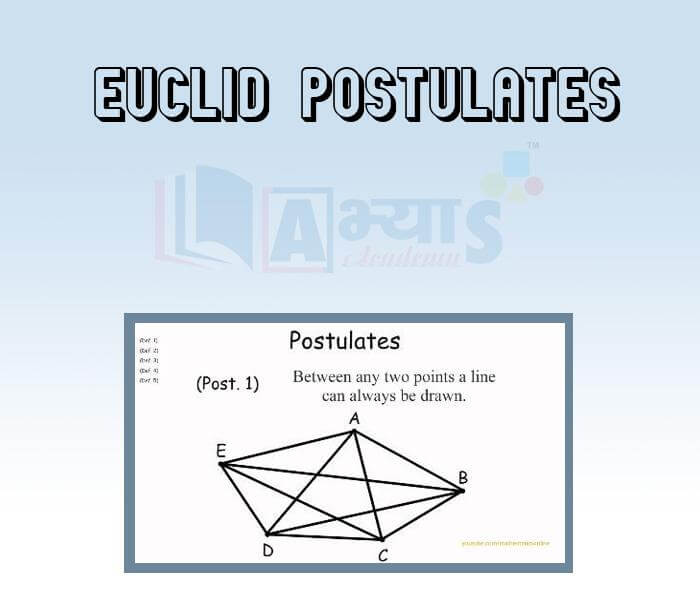Euclid Postulates

Euclid Postulates
EUCLIDS POSTULATES :
Postulate 1: A straight line may be drawn from any one point to any other point.
Note that this postulate tells us that at least one straight line passes through two distinct points, but it does not say that there cannot be more than one such line. However, in his work, Euclid has frequently assumed, without mentioning, that there is a unique line joining two distinct points. We state this result in the form of an axiomas follows:
Axiom: Given two distinct points, there is a unique line that passes through them.
How many lines passing through P also pass through Q ? Only one that is, the line PQ. How many lines passing through Q also pass through P? Only one, that is, the line PQ. Thus, the statement above us self-evident, and so is taken as an axiom.
Postulate 2: A terminated line can be produced indefinitely.
Note that what we call a line segmetn now-a-days is what Euclid called terminated line. So, according to the present day terms, the second postulate says that a line segment can be extended on either side to form a line.
Postulate 3: A circle can be drawn with any centre and any radius.
Postulate 4: All right angles are equal to one another.
Postulate 5: If a straight line falling on two straight lines makes the interior angles on the same side of it taken together less than two right angles, then the two straight lines, if produced indefinitely, meet on that sideon which the sum of angles is less than two right angles.
For example, the line PQ in fig. falls on lines AB and CD such that the sum of the interior angles 1 and 2 is less than on the left side of PQ. Therefore, the lines AB and CD will eventually intersect on the left side of PQ>
A brief look at the five postulates brings to your notice that Postulate 5 is far more complex than any other postulate.On the other hand, Postulates I through 4 are so simple and obvious that these ar taken as self-evident truths. However, it is not possible to prove them. So, these statements are accepted without any proof. Because of its complexity, the fifth postulate will be given more attention in the next section.
Example 1: Prove that an equilateral triangle can be constructed on any given line segment.
Solution: In the statement above, a line segment of any length is given, say AB (see fig.)
Here, you need to do some construction. Using Euclid,s Postulate 3, you can draw a circle with point A as the centre and AB as the radius (see fig. ). Similarly, draw another circle with point B as the centre and BA as the radius. The two circles meet at a point , say C. Now, draw the line segmetns AC and BC to form ABC (see fig. )
So, you haave to prove that this triangle is equilateral, i.e., AB = AC = BC.
Now, AB = AC, since they are the radiiof the same circle
Similarly, AB = BC (Radii of the same circle)
From these two facts, and Euclids axiom that things which are equal to the same thing are equal to one another, you can cpnclude that AB = BC = AC.
So, ABC is an equilateral triangle.
Note that here Euclid has assumed, without mentioning anywhere, that the two circles drawn with centres A and B will meet each other at a point.
Students / Parents Reviews [10]
Abhyas is a complete education Institute. Here extreme care is taken by teacher with the help of regular exam. Extra classes also conducted by the institute, if the student is weak.

Om Umang
10thMy experience was very good with Abhyas academy. I am studying here from 6th class and I am satisfied by its results in my life. I improved a lot here ahead of school syllabus.

Ayan Ghosh
8thIt has a great methodology. Students here can get analysis to their test quickly.We can learn easily through PPTs and the testing methods are good. We know that where we have to practice

Barkha Arora
10thAbout Abhyas metholodology the teachers are very nice and hardworking toward students.The Centre Head Mrs Anu Sethi is also a brilliant teacher.Abhyas has taught me how to overcome problems and has always taken my doubts and suppoeted me.

Shreya Shrivastava
8thA marvelous experience with Abhyas. I am glad to share that my ward has achieved more than enough at the Ambala ABHYAS centre. Years have passed on and more and more he has gained. May the centre flourish and develop day by day by the grace of God.

Archit Segal
7thMy experience with Abhyas is very good. I have learnt many things here like vedic maths and reasoning also. Teachers here first take our doubts and then there are assignments to verify our weak points.

Shivam Rana
7thIt was good as the experience because as we had come here we had been improved in a such envirnment created here.Extra is taught which is beneficial for future.

Eshan Arora
8thMy experience with Abhyas academy is very good. I did not think that my every subject coming here will be so strong. The main thing is that the online tests had made me learn here more things.

Hiya Gupta
8thOne of the best institutes to develope a child interest in studies.Provides SST and English knowledge also unlike other institutes. Teachers are co operative and friendly online tests andPPT develope practical knowledge also.

Aman Kumar Shrivastava
10thIt was a good experience with Abhyas Academy. I even faced problems in starting but slowly and steadily overcomed. Especially reasoning classes helped me a lot.




